Southwest Michigan field crops update – July 11, 2024
Large rainfall accumulations halted fieldwork and resulted in standing water in many fields. Most soybeans reached reproductive stages, and low levels of tar spot were confirmed in Branch County.

Weather
While last week saw frequent but light precipitation, coming out of the weekend precipitation became much heavier. Rainfall from the effects of Hurricane Beryl resulted in large precipitation accumulations, including over 4 inches in 24 hours in some areas. As the storm moved from the southwest corner of the state to the northeast, our region got hit harder than other parts of the state. Many fields have standing water. The article “Crops Under Water – Crop Stage is Critical for Recovery” from Ohio State University Extension outlines the expected effects of saturated soils on different crops by crop stage.
This upcoming week will see a frontal system over the weekend that is expected to drop up to an inch of water, followed by scattered showers and high dewpoints. Overall, the weather is still warmer than average, and crops continue to be ahead of historic.

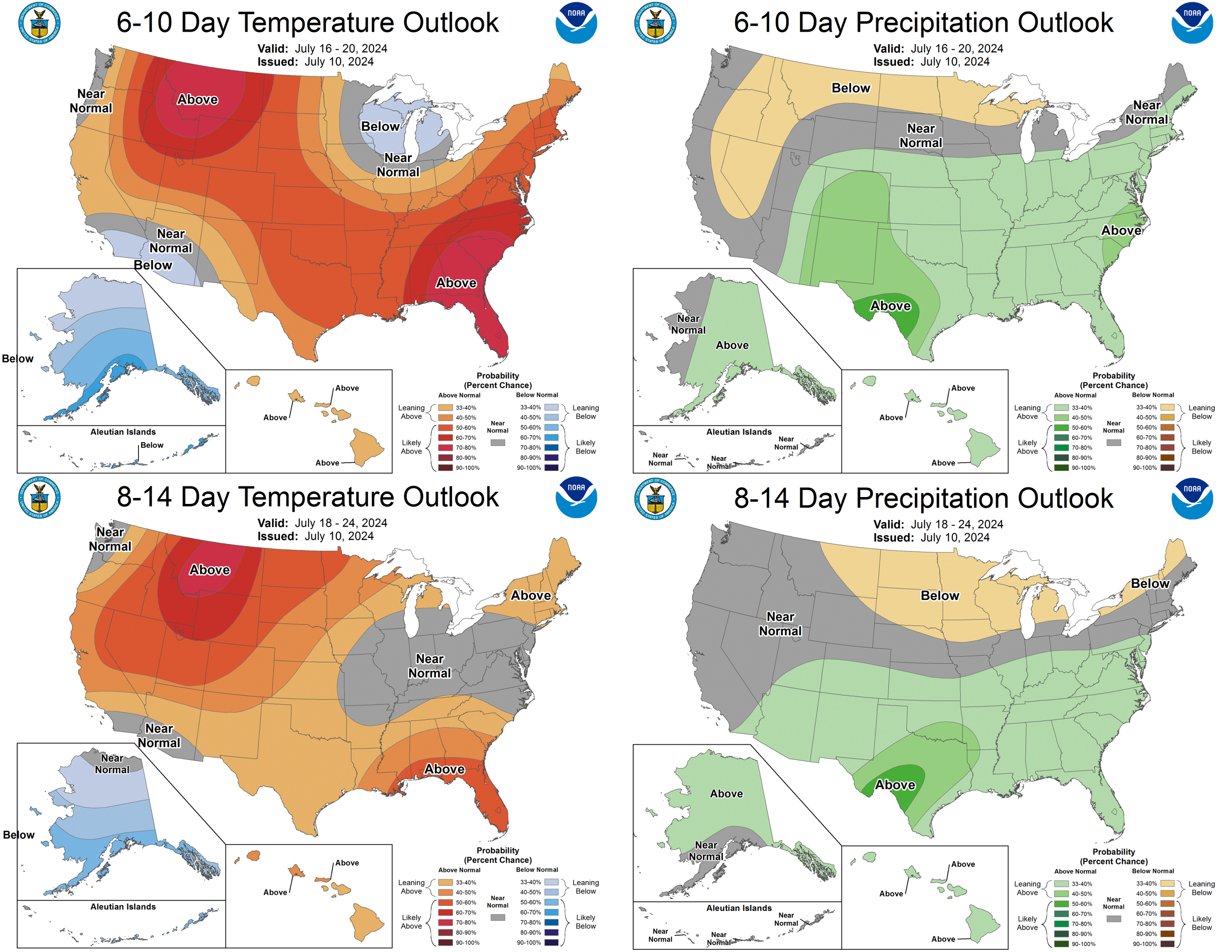

Crops and pests
Soybeans range from late vegetative stages to R4. Most soybeans are at R1 to R2 right now. According to the Michigan State University Extension article, “Identifying soybean reproductive growth stages,” a field reaches R1 when at least 50% of plants have an open flower at any node on the main stem. R2 is identified by one open flower on one of the two uppermost nodes that have a fully developed leaf, meaning the leaf is unfurled and the edges are no longer touching. R3 begins when any of the four uppermost nodes with a fully developed leaf has one pod of just under 0.25 inches (3/16 inches to be precise). At R4, one pod on any of the four uppermost nodes (with a fully developed leaf) is 0.75 inches long.
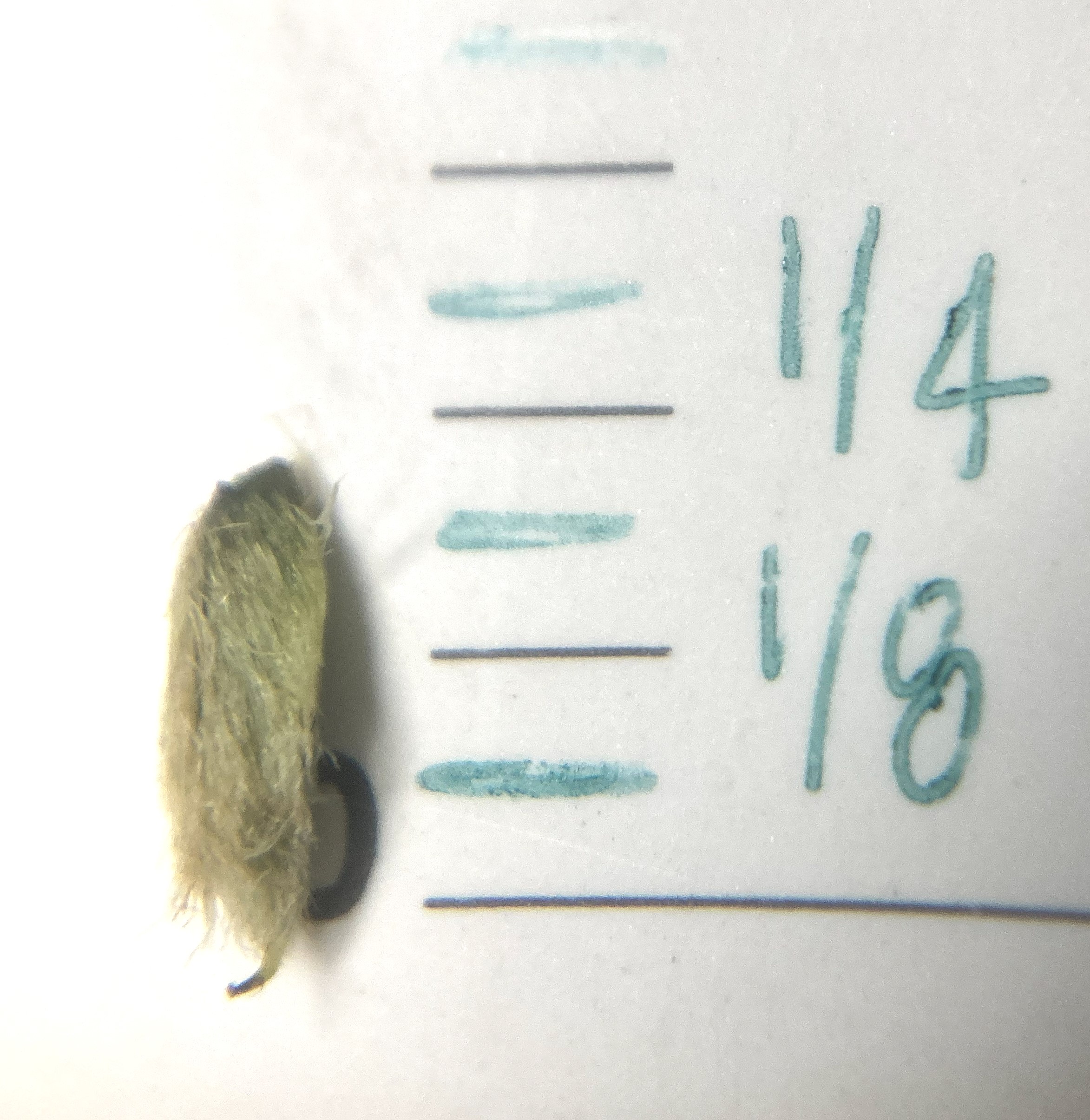
White mold fungicide applications should occur between R1 and R3. The Sporecaster app shows high white mold risk for today, July 11, in the westernmost counties and moderate risk farther inland. “Fungicide use for managing white mold in soybeans” from Michigan State University (MSU) Extension lays out some of the considerations for deciding to apply a fungicide for white mold or not. Phytophthora root rot also becomes a risk with the heavy rainfall, so keep an eye out for it in fields and send in samples to MSU Plant and Pest Diagnostics as needed.
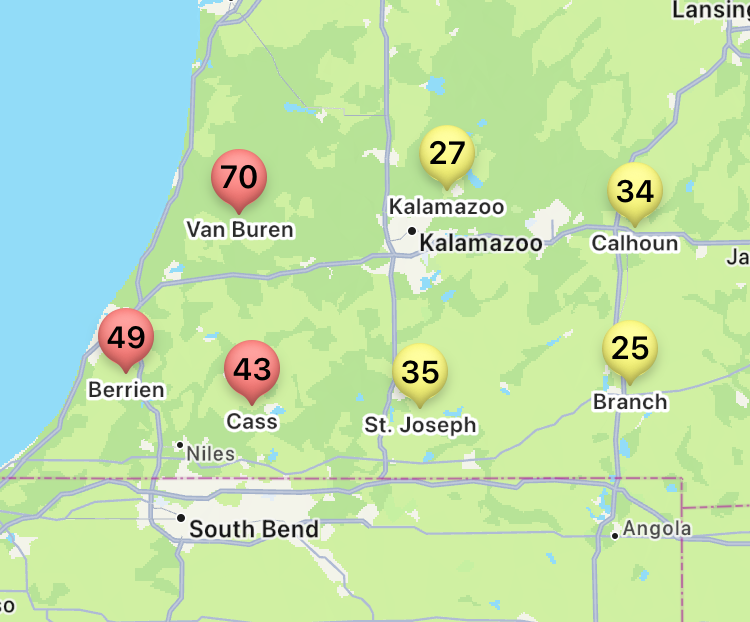
Corn has continued to tassel and some acres have now reached R1 (silks extend outside of husk leaves), primarily in earlier planted commercial corn. Relatively few seed corn acres have begun to tassel. With all the rain this week, nitrogen was at risk of leaching out of the root zone, depending on the rainfall and nitrogen application timing. In some cases, it may be necessary to sidedress more nitrogen (if the corn is short enough to allow equipment to pass), fertigate or fly dry fertilizer to address nitrogen deficiencies.
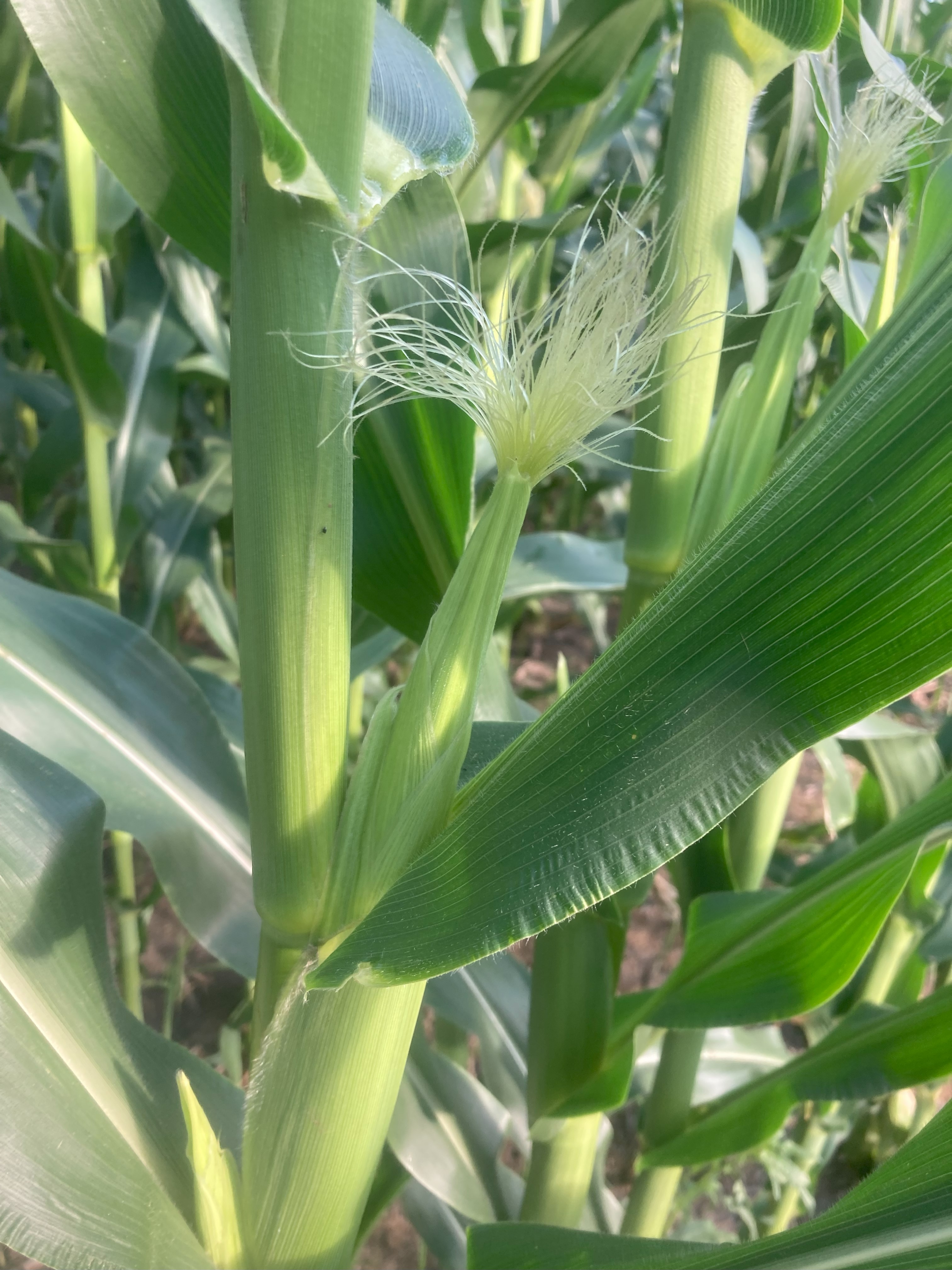
Tar spot has been found at low levels in Branch County and a couple others in eastern Michigan. The Tarspotter app shows that the tar spot risk for today, July 11, is down a little bit from last week, with most counties at moderate risk. Scout your fields to determine if a fungicide is needed. If applying a single fungicide application to manage tar spot, target VT to R3.
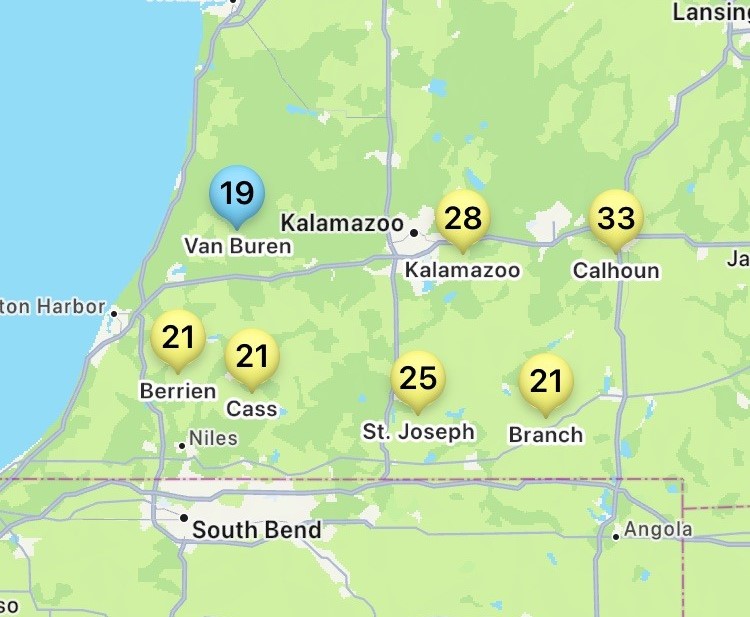
Western bean cutworm moths continue to fly, and the highest counts from the bucket traps this week were found in Cass County near Cassopolis, Michigan. Corn is most attractive for egg laying between pretassel and full tassel. Bucket traps in Branch (near Union City), Berrien (near Eau Claire), Cass (near Cassopolis) and St. Joseph (Centreville and Sturgis) counties have caught the following:
|
Date |
Berrien |
Cassopolis |
Centreville 1 |
Centreville 2 |
Sturgis |
Union City 1 |
Union City 2 |
|---|---|---|---|---|---|---|---|
|
6/24 |
2 |
0 |
6 |
9 |
0 |
5 |
3 |
|
7/1 |
1 |
81 |
29 |
46 |
29 |
61 |
4 |
|
7/8 |
4 |
123 |
40 |
34 |
22 |
90 |
31 |
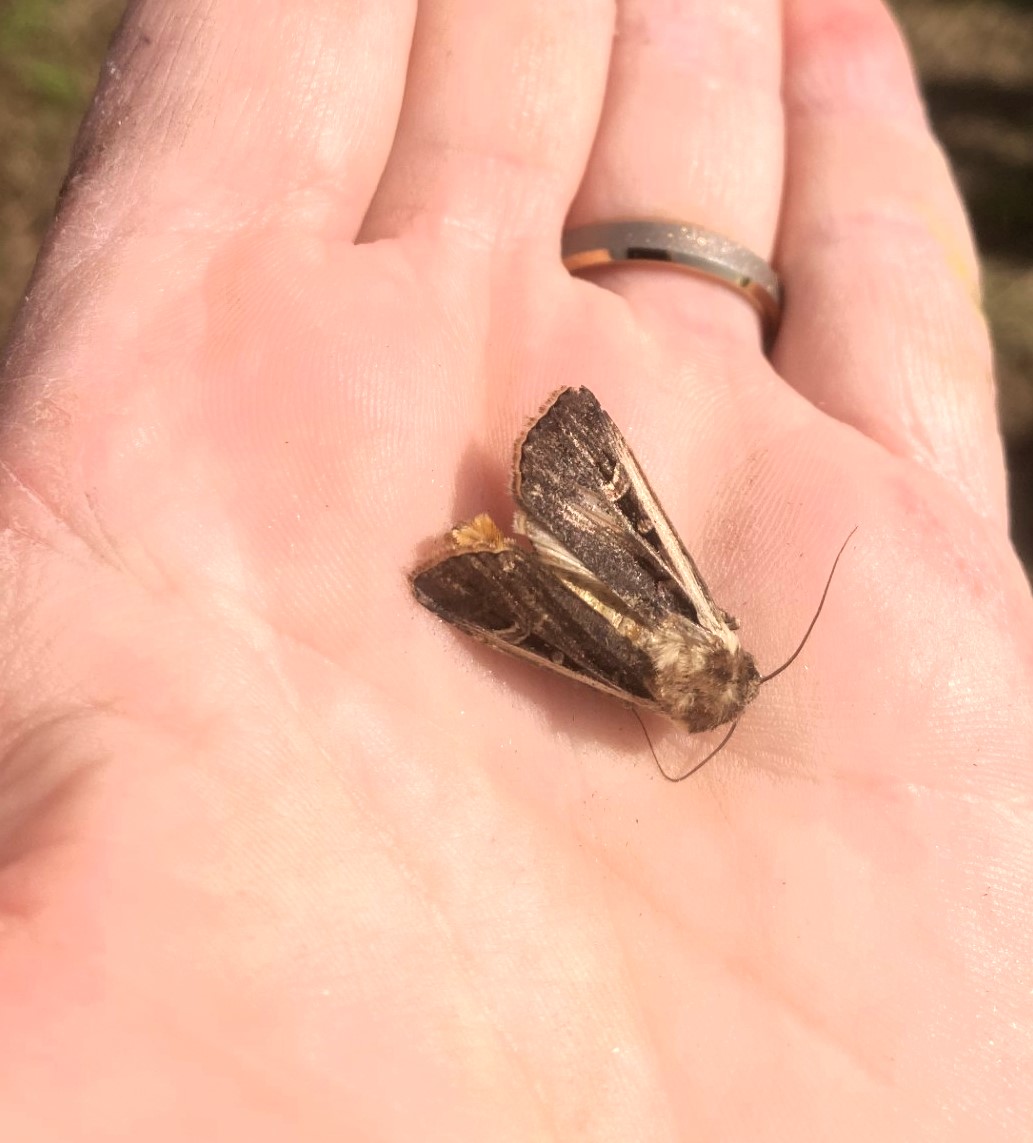
Some winter wheat remains unharvested due to the moisture received this past week. Wheat that sits in the field too long and with sufficient precipitation runs the risk of preharvest sprout.
Aphids are present on potatoes. Risks for both vine rot and tuber pathogen inoculation increased this past week due to the precipitation. Saturated soils cause lenticels (sites of gas exchange on the tuber) to swell and rupture to allow more oxygen into the tuber. Even after visible swelling of the lenticels goes down, it can take around a week for them to fully heal.
Alfalfa and forage cutting and baling has been delayed throughout the region due to the moisture received this past week. Some alfalfa has started to bloom, reducing hay quality. If you’re interested in more tips and information on forage management given recent weather conditions, check out the most recent Field Crops Virtual Breakfast Series on Wild Weather for Hay.
Weekly water use
|
Estimated weekly crop water use for field crops in Michigan (inches per week) — Week of July 8 – 14, 2024 |
||||
|
Crop |
Growth stage |
Constantine |
Entrican |
Hart |
|
Corn |
V8 |
0.69 |
0.69 |
0.73 |
|
V10 |
0.93 |
0.94 |
0.99 |
|
|
V12 |
1.23 |
1.24 |
1.30 |
|
|
VT |
1.35 |
1.36 |
1.43 |
|
|
Silk |
1.35 |
1.36 |
1.43 |
|
|
Soybeans |
V2 2nd node |
0.62 |
0.62 |
0.65 |
|
V3 3rd node |
0.74 |
0.74 |
0.78 |
|
|
R1 Beginning bloom |
1.23 |
1.24 |
1.30 |
|
|
R2 Full bloom |
1.35 |
1.36 |
1.43 |
|
Corn water use remains at its peak during tasseling, and soybeans are still in the R1 and R2 stages, which require crop water use monitoring to avoid water stress. However, for all crops, it is crucial to track the accumulated rainfall received so far this week, as it should have covered the weekly crop water needs.
The table above presents estimated crop water use for various field crops across three locations in Michigan. This data helps irrigation management decisions by showcasing potential crop evapotranspiration, calculated based on reference evapotranspiration and crop coefficients for each crop growth stage. It is crucial to note that crop water use values vary across regions due to differences in weather conditions, growth stages, agronomic practices and soil properties.
When using these values for irrigation scheduling, be mindful that they assume all applied irrigation water will be utilized by the plants without any loss. Additionally, these values do not account for any precipitation that may occur during the week of calculation. For more tools and information on irrigation scheduling tools, please refer to: Irrigation Scheduling Tools.
Reference evapotranspiration data was obtained from MSU Enviroweather, which also offers a model for determining potential crop evapotranspiration. To access this tool, visit Enviroweather, click on "Crops," select your crop and use the potential evapotranspiration tool by choosing your nearest weather station, the latest date of interest and other crop information.
Field Crops Virtual Breakfast Series

Wild weather for haymaking, presented by Kim Cassida, was the topic for the MSU Extension Field Crops Virtual Breakfast Series this week. Weather extremes cause stress, and too much stress kills forages. Weather also affects hay cutting and baling decisions and impacts hay quality. Recordings of this and all the Virtual Breakfast meetings are closed-captioned and available at the Field Crops Virtual Breakfast webpage and the MSU Extension field crops team social media platforms: Facebook, Spotify, YouTube, Apple Podcasts and Twitter.



 Print
Print Email
Email